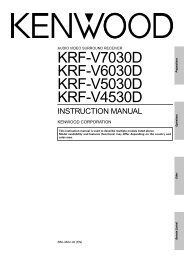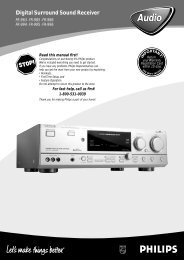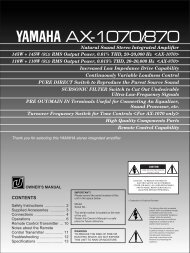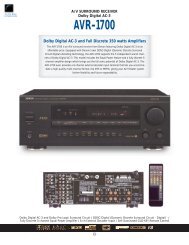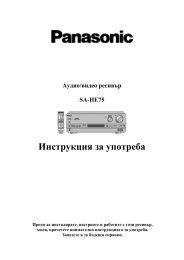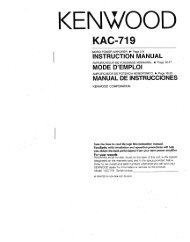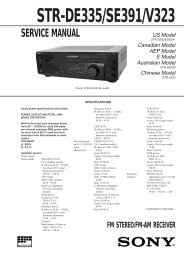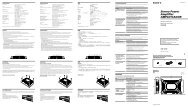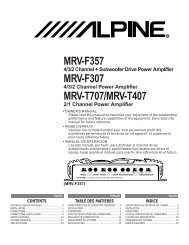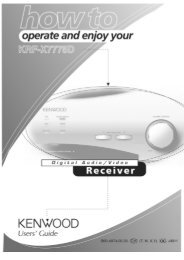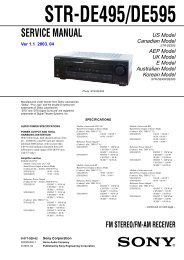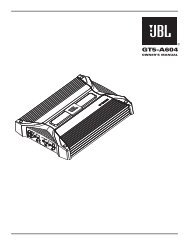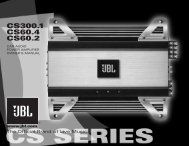DLS D 1000.pdf - Hifi-pictures.net
DLS D 1000.pdf - Hifi-pictures.net
DLS D 1000.pdf - Hifi-pictures.net
Create successful ePaper yourself
Turn your PDF publications into a flip-book with our unique Google optimized e-Paper software.
OWNERS MANUAL<br />
CAR AUDIO AMPLIFIER<br />
D 1000<br />
Digital class ”D” mono amplifier for subwoofer use<br />
1000 watts output power into 1 ohm load<br />
NOTE!<br />
Read this manual thoroughly<br />
before you start to install<br />
<strong>DLS</strong> Svenska AB<br />
Box 13029<br />
SE-402 51 Göteborg<br />
Sweden<br />
Phone +46 31 84 00 60<br />
Fax +46 31 84 40 21<br />
E-mail: info@dls.se<br />
www.dls.se
TABLE OF CONTENTS<br />
Congratulations, you have just purchased the finest Car Audio amplifier that today´s technology can offer.<br />
<strong>DLS</strong> offers a series of high quality car audio products for real music lovers, and we are sure that you will<br />
enjoy a high class car sound for many years.<br />
Read the owners manual first!<br />
To maximize the performance of your system, we recommend that you thoroghly acquaint yourself with it´s<br />
capabilities and features. Please take your time to study this manual before starting the installation. Then<br />
you hopefully know how to do a correct installation avoiding connecting errors that can cause damage to<br />
this fine product. Retain this manual for future reference.<br />
TABLE OF CONTENTS:<br />
Page 2<br />
Page 2<br />
Page 2<br />
Page 2<br />
Page 3<br />
Page 3-4<br />
Page 4<br />
Page 4<br />
Page 4<br />
Page 4<br />
Page 4<br />
Page 4<br />
Page 5<br />
Page 5<br />
Page 5<br />
Page 5<br />
Page 6<br />
Page 7<br />
1. GENERAL PRODUCT INFORMATION<br />
2. INSTALLATION PREPARATION<br />
2.1 Location<br />
2.2 Power cables<br />
2.3 Signal cables<br />
2.4 Speaker connection, speaker loads, speaker polarity check<br />
2.5 Level setting<br />
2.6 Final system setup<br />
2.7 Protection circuits<br />
3. INTERNAL FILTERS<br />
3.1 Lowpass / Highpass<br />
3.2 Bass boost<br />
4. FAULT FINDING GUIDE<br />
4.1 Noise problems<br />
5. REMOTE SUB LEVEL CONTROL<br />
6. SPECIFICATIONS<br />
7. CONNECTION DIAGRAM<br />
For your own notes<br />
CAUTION!<br />
Some of our amplifiers are capable of producing a sound pressure level that can cause permanent<br />
damage to your hearing system. High sound pressure levels combined with long time listening can give<br />
permanent damage to your hearing system. Choose a listening level that is comfortable for your ear.<br />
To establish a safe level:<br />
Start your volume control at a low setting. Slowly increase the volume until you can hear the music<br />
comfortly and clearly, without any distortion. Sudden sound shocks are dangerous.<br />
The following noises can be dangerous with constant exposure:<br />
90 dB Subway, motorcycle, lawn mover 4 hours max<br />
100 dB Chain saw 2 hours max<br />
120 dB Rock band live concert 30 minutes max<br />
140 dB Gunshot blast, jet plane 0 minutes<br />
- 1 -
GENERAL, POWER CABLING<br />
1. General product information<br />
Thank you for buying a <strong>DLS</strong> amplifier. This amplifier<br />
is a high quality product and is a result of many<br />
years of experience of building high quality sound<br />
products for vehicles.<br />
We recommend you to carefully read this manual<br />
before you start to install. Be sure to follow all<br />
recommendations in the installation section. If you<br />
do so we are sure that you will be able to enjoy a<br />
perfect sound for a long time,.<br />
2. Installation preparation<br />
2.1 LOCATION<br />
We recommend you to do a careful planning before<br />
you start to install this equipment.<br />
Choose a location for the amplifier which will allow<br />
plenty of air to circulate around the fins on the top of<br />
the case. Vertical mounting is to prefer. Do NOT mount<br />
the amplifier upside down under the hat rack.<br />
In the amplifier case there are double mounting holes<br />
to make the installation job easier. The screws<br />
supplied in the plastic bag are self drilling when used<br />
with an electric screwdriver.<br />
If the surface where you intend to mount the amplifier<br />
isn´t big enough you can mount the amplifier on a<br />
separate fibre board or similar. This will also isolate<br />
the amplifier chassies from ground.<br />
NOTE! Before you start drilling, make sure that<br />
there are no fuel or brake lines or wiring looms<br />
behind where you intend to drill.<br />
2.2 POWER CABLES<br />
The DC power wiring is extremely important. It is<br />
essential that the amplifier at all occassions gets all<br />
the power it needs without voltage drop, otherwise<br />
both the dynamics and the good sound will be lost.<br />
A poor battery can also cause a bad sound<br />
reproduction, escpecially in the bass range. Sometimes<br />
it is necessary to mount an extra battery.<br />
The speaker cable connections requires a 2 mm hexagon<br />
key to connect the terminals, and the power cable<br />
connections require a 4 mm hexagon key.<br />
In most cases a so called ”Power Cap” can be useful.<br />
It is an energy storage capacitor designed to supplement<br />
audio amplifiers during high current demand. The<br />
overall bass response of your audio system will be<br />
enhanced with the use of this due to it´s ability to<br />
store a large amount of current and discharge it in a<br />
short period of time.<br />
In the table below you will find suitable cable and fuse<br />
sizes for different cable lenghts.<br />
The gold plated terminals will directly recieve<br />
power cables up to 21 mm 2 (4AWG).<br />
Mount the fuse holder included in the amplifier on the<br />
DC -cable near the positive battery terminal. Use the<br />
same cable size from the negative amplifier terminal<br />
and connect to the nearest earth point.<br />
The Fuse holder accepts cables up to 21mm 2 if you<br />
remove the inner bushing. If you are using heavier<br />
cables use another type of fuse holder or cut some of<br />
the strands in the cable.<br />
Make sure to have a good earth contact, if necessary<br />
clean the metal from paint etc. A poor earth contact<br />
can cause damage to other parts in the system, for<br />
example the head unit if the earth current is forced to<br />
pass through the shield of the signal cable.<br />
Recommended cable size for the DC-feed.<br />
Cable length: < 1,5 m 1,5 - 5 m > 5 m<br />
D 1000 16 mm 2 21 mm 2 33 mm 2<br />
Recommended main fuse for D 1000:<br />
Amplifier Fuse value Fuse holder<br />
D 1000 AGU 80 A FH1/FH1B<br />
A cable of a certain size can´t have an oversized fuse,<br />
then the cable gets too warm before the fuse blows.<br />
Max fuse values for different cable sizes:<br />
6 mm 2 (9 AWG) 25 A<br />
10 mm 2 (7AWG) 40 A<br />
16 mm 2 (5AWG) 60 A<br />
21 mm 2 (4AWG) 100 A<br />
33 mm 2 (2AWG) 140 A<br />
42 mm 2 (1AWG) 200 A<br />
If you have more than one amplifier in the system<br />
you must increase the cable size and fuse compared<br />
to the table. When connecting two or more amplifiers<br />
use some of the <strong>DLS</strong> Fuse blocks with built in fuses<br />
to split the power to each amplifier. The short cable<br />
from the Fuse block to the amplifier can have a smaller<br />
size for easier installation.<br />
Don´t connect to battery before you have double<br />
checked all connections.<br />
Fuse<br />
Fuse block<br />
Battery 12 V<br />
2 amplifiers<br />
- 2 -
CABLING, SIGNAL CABLES, SPEAKER CONNECTION<br />
2.3 SIGNAL CABLES<br />
D 1000 has two gold plated phono socket pairs. The<br />
upper pair is used to recieve the signal from the head<br />
unit and the lower pair has a line out function if you<br />
want to connect to more amplifiers.<br />
Both inputs must recieve an input for full power output.<br />
Use high quality interconnects like the <strong>DLS</strong> SL5 PRO<br />
or similar with an effective shielding that prevents<br />
interference from the engine or alternator. When<br />
using this cable you must run a separate wire for the<br />
remote.<br />
When you run the signal cables remember to keep<br />
them well spaced from the wiring loom and the power<br />
feed to the amplifier to avoid picking up interference.<br />
Lay the power cables and signal cables separated<br />
on each side of the car. Any extra cable must be laid<br />
in zig-zag style and definitely not coiled. Or cut it to<br />
correct lenght.<br />
REMOTE WIRE<br />
Some signal cables include a thin wire for remote<br />
amplifier start. High quality cables normally requires<br />
a separate wire for this. Connect between the head<br />
units remote cable (often the same cable that´s used<br />
for automatic power antennas) and the REM-terminal<br />
on the amplifier.<br />
NOTE! If you want to start more than one amplifier<br />
using the remote output, the current load might be<br />
too high for som head units. High currents may<br />
damage the head unit, check in the manual for the<br />
head unit. Sometimes you must add a relay to the<br />
remote circuit that takes care of the higher current. If<br />
you are uncertain of how to connect the relay, ask<br />
your local <strong>DLS</strong> dealer for advice.<br />
PROTECT YOUR CABLES!<br />
To prevent the cable insulation from beeing damaged<br />
over sharp metal edges we recommend the use of<br />
cable protection tubes or similar. A damaged cable<br />
insulation could cause serious damage to the amplifier<br />
not covered by any guarantee.<br />
SPEAKER POLARITY CHECK.<br />
All speakers in a car audio system should be<br />
connected in phase (the same polarity). All speaker<br />
cones must move in the same direction. Out of phase<br />
speakers will cause a lack of bass, and a poor stereo<br />
soundstage.<br />
Checking polarity:<br />
Hold the - connection of the speaker wire to the -<br />
terminal of a 1,5 Volt flashlight battery. Tap the + wire<br />
on to the + terminal of the battery, and observe the<br />
movement of the cone. The cone should move<br />
outwards when the wire touches the battery, and<br />
inwards when the battery is removed. If it is the other<br />
way around, the speaker has been connected<br />
backwards and it must be removed and connected<br />
correctly.<br />
If your system also has a subwoofer connected<br />
through a passive 6 or 12 dB crossover, try to connect<br />
this with various polarity and judge what sounds best.<br />
The phase shift in passive crossovers sometimes<br />
makes it necessary to change polarity.<br />
+<br />
Battery<br />
1,5<br />
Volt<br />
-<br />
NOTE! Tweeters can not be tested this way, double<br />
check the connections instead.<br />
+<br />
-<br />
2.4 SPEAKER CONNECTION<br />
There are double speaker connections internally<br />
connected to each other. The reason for having<br />
double connections is for making it easier to<br />
connect more than one speaker.<br />
The gold plated terminals will directly recieve<br />
speaker cables up to 6 mm 2 (9AWG). Always<br />
use high quality speaker cables such as <strong>DLS</strong><br />
SC 2x2,5 or SC 2x4.<br />
Connect the speaker + (marked with + or a red<br />
dot) to the amplifier + terminal, and the speaker<br />
- to the amplifier -.<br />
When fitting the cables to the terminals, remove<br />
only 10 mm of the insulation. Twist the wire<br />
strand together and insert the wire after<br />
loosening the terminal screw. Do not over tighten<br />
as this can cut the cable strands. Use a 2 mm<br />
hexagon key to the terminals.<br />
SPEAKER LOADS<br />
Most car audio speakers have a 4 ohm impedance.<br />
D 1000 can be loaded down to 1 ohm.<br />
When loaded with one 4 ohm speaker the output power<br />
is 350 Watts. When loded with two 4 ohm speakers in<br />
prallel (2 ohm load) the output power is 700 Watts,<br />
and when loaded with four 4 ohm speakers connected<br />
in parallel the output power is up to 1000 Watts.<br />
On page 4 you find different speaker wiring examples.<br />
- 3 -
SPEAKER CONNECTION, FILTER SETTINGS<br />
SPEAKER CONNECTION EXAMPLES<br />
TWO 4 OHM SPEAKERS IN PARALLEL.<br />
+ +<br />
+<br />
2 ohm<br />
- -<br />
2.6 FINAL SYSTEM SETUP<br />
Before connecting the amplifier to the battey, recheck<br />
all connections. When you connect the main fuse<br />
you will see a little spark, this is normal. But if the<br />
fuse blows at this moment, something is wrong.<br />
Recheck the cabling.<br />
Turn on your head unit, the amplifier starts and the<br />
green POWER LED is lit. Increase the volume and<br />
make sure all speaker works. Readjust levels and<br />
crossover settings if necessary.<br />
TWO 4 OHMS SPEAKERS IN SERIES.<br />
+<br />
8 ohm<br />
- - -<br />
Not a recommended way to connect, the power is<br />
only half.<br />
PARALLEL TO 1 OHM.<br />
+<br />
1 ohm<br />
-<br />
Each speaker is 4 ohm<br />
2.5 LEVEL SETTING<br />
To adapt the amplifier to all kind of signal sources<br />
with varying levels there are a level control provided<br />
on the amplifier next to the phono sockets. It should<br />
not be used as volume controls.<br />
Start with a ”12 o clock” setting of the level controls.<br />
If you set the head unit volume to 75% of maximum<br />
you should achieve a good sound without distortion.<br />
Find a point of the level setting where the distortion is<br />
just discernible. At this point slightly reduce the control<br />
to eliminate the distorsion.<br />
If you have a system with an amplifier for the front<br />
stereo system it´s necessary to adjust the levels<br />
indiviually to achieve a good sound balance between<br />
the different speakers, different speakers have different<br />
sensitivity. Start the level adjustment on the mono<br />
amplifier. After having adjusted the bass level for good<br />
performance, adjust the level to the front system<br />
amplifier for a good sound balance.<br />
+<br />
+<br />
2.7 PROTECTION CIRCUITS<br />
PROTECTION LED<br />
The amplifier has internal protection. The red<br />
protection LED is illuminated when fault condition<br />
exists and the amplifier immideately shuts down. If<br />
illuminated, turn amplifier off, check for shorted speaker<br />
wires and attempt to re-power amplifier. When<br />
the amplifier overheat and thermal protection shuts<br />
the amplifier off, the LED does not illuminate.high<br />
current protection circuit shutting down the amplifier<br />
if the current draw is too high.<br />
OVERLOAD LED<br />
Allow self-test when power is turned on and then LED<br />
should be illuminated during checking. It should be<br />
automatically turned off 3 seconds later. It will<br />
illuminate if there is trouble like speaker short or if<br />
any part of the amplifier is overloaded.<br />
3. Internal filters<br />
3.1 Lowpass / Highpass<br />
D 1000 has an internal variable lowpass filter. It can<br />
be set from 35 up to 250 Hz. It also has an internal<br />
higpass subsonic filter that can be set from 15 up to<br />
35 Hz.<br />
LOWPASS FILTER:<br />
The lowpass filter is normally used together with a<br />
subwoofer to remove higher frequencies over the<br />
crossover setting. A normal filter setting is 80 - 100<br />
Hz.<br />
HIGHPASS FILTER:<br />
The highpass filter should be used as a subsonic filter<br />
together with a subwoofer to remove the lowest<br />
frequencies which often causes a rumbling bass<br />
reproduction. A normal setting is 20 - 30 Hz.<br />
3.2 BASS BOOST CONTROL<br />
Adjust the sub boost level of the selected frequency<br />
output from 0 to 18 dB.<br />
- 4 -
FAULT FINDING GUIDE<br />
4. Fault finding guide<br />
If problems occour during the installation, or later, this<br />
guide might help you to find out whats´s wrong.<br />
THE AMPLIFIER IS DED:<br />
1. Check power lead, ground and remote connections<br />
at the amplifier using a voltmeter.<br />
2. Check the battery terminal connections.<br />
3. Check the power lead fuse or circuit breaker. If<br />
fuse damage continues, inspect the power lead for<br />
short circuits.<br />
4. To start the amplifier requires a remote voltage of<br />
9-15 volt. Check the voltage with a voltmeter.<br />
AMPLIFIER PROTECTION CIRCUITS TURNS THE<br />
AMPLIFIER OFF<br />
1. One or more speaker cables are shorted. Make an<br />
insulation test with a multi meter. The cables must<br />
not have a connection to earth.<br />
THE AMPLIFIER TURNS OFF AFTER 10 - 30 MINU-<br />
TES.<br />
The amplifier is overheating due to inadequate ventilation.<br />
Check mounting position is free from<br />
obstruction.<br />
Do this:<br />
1. Move the amplifier to a place with better ventilation.<br />
2. Install one or two fans to cool down the heatsink.<br />
3.Overheating can also be caused by an impedance<br />
load below the level permitted. Refer to the section<br />
about speaker loads.<br />
4.1 NOISE PROBLEMS<br />
WHINING NOISE VARYING WITH ENGINE<br />
REVOLUTIONS:<br />
Do this:<br />
1. Rewire the power supply (12 V) to source unit<br />
direct from battery.<br />
2. Rewire ground wire from source unit to clean<br />
position on chassis.<br />
3. Check all power connections to ensure that they<br />
are clean and tight.<br />
4. Check quality of system ground connection.<br />
CONSTANT WHINING NOISE:<br />
Do this:<br />
1. Ensure that all equipment is grounded at the same<br />
place.<br />
2. Check quality of earth strap connection from battery<br />
negative terminal to chassis.<br />
3. Disconnect signal cables from amplifier to see if<br />
noise disappears. If so the leads are picking up noise.<br />
Test this by laying a new cable over the seats and<br />
reconnecting to the amplifier. If the noise does not<br />
return, re-route original cable away from source of<br />
interference.<br />
If noise remains regardless of cable position, try to<br />
use so called Quasi-balanced signal cables. <strong>DLS</strong><br />
PRO-cables are Quasi-balanced.<br />
5. Remote sub level control<br />
A remote sub level control is coming with this amplifier.<br />
The 6-pole modular cable should connect between the<br />
REMOTE socket on the amplifier and the socket on<br />
the back of the external remote control box.<br />
Fasten the remote control box under the dashboard<br />
or in a way that does not violate the car safety<br />
regulations of your country.<br />
The remote sub level contro lallows you to adjust the<br />
bass level of the sound individually, making it easier<br />
to get just the bass level you want in different kinds<br />
of music.<br />
6. Specifications<br />
MODEL D 1000<br />
Digital class ”D” subwoofer amplifier<br />
Channels 1<br />
Mode<br />
D<br />
Output power at 14,4 Volt:<br />
4 ohm nom. power RMS (0,3% THD) 350 Watts<br />
2 ohm nom. power RMS (0,5% THD) 700 Watts<br />
1 ohm nom. power RMS (1% THD) 1000 Watts<br />
S/N ratio, A-weighted<br />
> 80 dB<br />
Damping factor 4 ohm 100 Hz > 300<br />
Frequency response<br />
27 - 235 Hz<br />
Input sensitivity<br />
0,2 - 6 volt<br />
Input impedance<br />
22 kohm<br />
Efficiency 80%<br />
Crossover, subsonic<br />
15 - 35 Hz<br />
Crossover, lowpass<br />
35 - 250 Hz<br />
Bass EQ (boost)<br />
18 dB (46 Hz)<br />
Fuses(external)<br />
80 A<br />
Max size for power cables 21 mm 2<br />
Max size for speaker cables 6 mm 2<br />
Protection circuits<br />
Current and thermal<br />
Power consumption:<br />
Idle<br />
Max current<br />
Remote<br />
Dimensions:<br />
Width<br />
Heigth<br />
Depth<br />
Weigth<br />
0,9 A<br />
97 A<br />
30 mA<br />
407 mm<br />
65 mm<br />
240 mm<br />
5,4 kg<br />
Use a 2 mm hexagon key for the remote and<br />
speaker terminals.<br />
Use a 4 mm hexagon key for the power terminals.<br />
- 5 -
1234<br />
1234<br />
1234<br />
1234<br />
CONNECTION DIAGRAM D 1000<br />
7. Connection diagram D 1000<br />
This amplifier is constructed for use as a subwoofer amplifier. All features on the amplifier is made for this<br />
purpose. It is possible to connect speakers in many various ways as long as the impedance load is not<br />
lower than 1 ohm. The speaker terminals on the amplifier are internally connected in parallel.<br />
D 1000 can be connected in some of these ways:<br />
Subwoofers with single 4 ohm voice coil:<br />
1. With one subwoofer connected to one of the terminals.<br />
2. With two subwoofers, one to each terminal.<br />
3. With three subwoofers, two to one terminal and one to the other terminal.<br />
4. With four subwoofers, two in parallel to each terminal.<br />
Subwoofers with dual 4 ohm voice coil:<br />
1. One subwoofer with the separate voice coils connected one to each terminal.<br />
2. Two subwoofers with the voice coils connected in parallel on each subwoofer and then connected with<br />
one subwoofer to each terminal.<br />
There are a number of more ways to connect if you have more than four subwoofers as long as the<br />
impedance load to the amplifier is not lower than 1 ohm.<br />
Four 4 ohm subwoofers<br />
connected in parallel.<br />
The speaker impedance is 4 ohms in this<br />
example giving an amplifier load of 1 ohm.<br />
For filter setting see page 4.<br />
POWER INPUT<br />
+12V REM GND<br />
SPEAKERS<br />
+ SP - - SP +<br />
REMOTE<br />
PROTECT<br />
LEVEL BASS BOOST LOWPASS SUB SONIC<br />
POWER<br />
LINE INPUT<br />
L R<br />
1234<br />
OVERLOAD<br />
Min<br />
Max<br />
0 dB 18 dB 35 Hz 250 Hz 15 Hz 35 Hz<br />
L<br />
R<br />
LINE OUT<br />
Fuse<br />
80 A<br />
+ +<br />
-<br />
-<br />
Sub level<br />
remote control<br />
Battery<br />
12 volt<br />
+<br />
+ +<br />
-<br />
-<br />
FM1 101,9<br />
Pre<br />
out<br />
Remote<br />
- 6 -
FOR YOUR OWN NOTES<br />
Notes about the product:<br />
Model no:_________________________________ Serial number:_______________________________<br />
Retailer:______________________________________________________________________________<br />
Date of purchase: _________________________ Date of installation: ___________________________<br />
Make your own installation notes about connections, crossover setup or just draw your own system<br />
schematic.<br />
- 7 -



